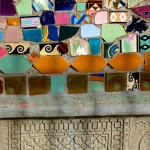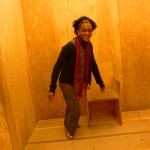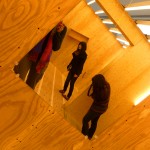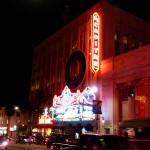Contemporary Art in Los Angeles: Day 1
Tuesday, January 11, 2011
10:00 am: The Watts Towers, Los Angeles, California
Upon first seeing the Towers, I couldn’t help but compare them to the Templo de la Sagrada Família, designed by Antoni Gaudí in Barcelona (as I’m sure many people have). Of course, the Watts Towers are much smaller, less “designed,” and were conceived of and constructed by one man: Simon Rodia. It took 34 years for Rodia to complete the sturctures, comprised of cement, tiles, shells, glass, clay, wire, and variety of other found materials. Although the ownership and preservation of the Towers has been highly contested over the years, they still remain a monument to Rodia’s homeland of Nola, Italy, and the unique, diverse culture of Southern California.
11:15 am: Uta Barth Studio Visit, Mar Vista, California
Uta Barth is a renowned photographer who has been in Los Angeles since the early 1990s. During our visit to her studio, she explained the trials of being an up-and-coming artist during those years—when 70% of the galleries in L.A. closed and there was a nationwide crash in the art market—and compared them to the current economic downfall (which was a bit disheartening to at least half of the group comprised of 2nd year MFA students trying to figure out what they were going to do with their lives after they graduate this May). After knocking some of our hopes and dreams down to size, Barth described her work to the class. She gave a disclaimer that her work is not in reference to the history of photography, but rather is a means of examining phenomena and perception. The camera, she clarified, is a “looking device”—the closest thing to the human eye in terms of what is seen and how it is perceived. Barth uses the camera to focus on a particular area in a space, leaving the rest of the image out of focus, just as our eyes would perceive it. In addition, she uses digital imaging to manipulate the photos so they more closely match our perception. This includes optical afterimages: the inverted image we see immediately after we close our eyes. According to Barth, the content of her work is not at all about a metaphor, narrative, or analogy; it is about the relationship between the viewer and the maker via lens of the camera.
1:20 pm: Lunch at Noodle Planet, Los Angeles, California
We broke for lunch before heading into the Hammer Museum on the UCLA Westwood campus. I ended up heading to an Asian noodle spot called Noodle Planet with few other students from the group. It was pretty cold for L.A. (which is about 55°F), so it was great to warm up with a huge bowl of Chinese BBQ Pork Wonton Noodle Soup!
2:00 pm: The Hammer Museum, Los Angeles, California
In the afternoon, we entered the Hammer Museum—part of the University of Southern California—which exclusively exhibits contemporary art. Although this was one of the smaller museums we would visit, I was unable to see everything in the amount of time we were given. The standout piece for me was Julian Hoeber’s Demon Hill (2010), a wooden room tilted at a vertigo-inducing angle. Other works of interest included:
- Katy Schimert. Monster #1 (2008). Watercolor.
- John Altoon. Untitled (C/I-2) (1968). Pen and ink with airbrushing.
- Jacob Yanes. Sara (2007). Cotton, rice paper, papyrus, and plywood base.
- Monica Majoli. Hanging Rubberman #1 (2006). Watercolor and gouache on paper.
3:20 pm: Kevin Appel Studio Visit, Brentwood, California
In terms of studio visits for the day, Uta Bartha was the “ying” and Kevin Appel was the “yang” (I sincerely apologize for the analogy). Compared to Barth’s studio, which was very dark and modern, Appel’s was light, spacious, and natural. The overall tone of the visit was more positive as well. Appel’s earliest work has a strong connection to architecture: painted renderings of transparent interior spaces and imagined floor plans. These works later turned into paintings of “ecological and domestic chaos”: houses stacked upon one another with the textures and elements of formal architecture “turned inside-out.” Currently, Appel paints geometric patterns (Screens) or clusters (Constructions) on top of enlarged photographs from nature/travel publications circa 1965. The idea involves “the abstract built up upon the non-abstract”: solid forms layered on top of realistic images.
In addition to being a practicing artist, Appel also teaches at the University of California Irvine, which he describe as a bit of a mixed blessing. Teaching allows him to be part of the constant flow of new ideas from within the institution, but it also inhibits the amount of thought and time he can dedicate to his own work. However, Appel encouraged our group to look at Los Angeles as a place to start a career as an artist; the art community does not completely revolve around the top-notch schools in the area. Here are some other useful bits of advice that Appel gave to us:
- Stay true to yourself and your own interests and ideas. Don’t feel pressured to do what is “hot” at the moment.
- Teaching is a good way to keep up with the pace of the art world.
- Don’t shy away from commercial art (Appel also works as a graphic designer).
- Look into opportunities all over the globe. Seek out “investors”: people who love your work and want to support your talent.
- Search for residencies!
- Research institutions will give you the most freedom to do your work.
- If you are interested in teaching, look for tenure-tracked positions.












Hey! I’m trying to decide whether I should go on this trip or do a CO-OP. How costly was this trip in terms of what the school made you pay (excluding tuition). I already see that you’ve enjoyed it quite a lot. Your posts are really helpful!
Hi Natasha,
From what I remember, the trip wasn’t too expensive. I believe the trip fee was $250 (half of what other study trips cost) and the only other expenses were food, lodging, and transportation to and around L.A. I split a hotel room with another student to keep the cost down. It also helps to start looking for flights early so you can get a good deal. Overall, I definitely think its a worthwhile trip. However, CO-OP/internship experience is very valuable. You’ll have to wage the pros and cons of each. Hope that helps!